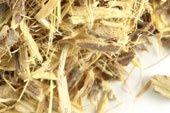Licorice Root
Licorice, or gan cao in Traditional Chinese Medicine, is a perennial plant in the bean family found in certain parts of Europe and Asia. The plant grows on a spreading root system that consists of fibrous, wood-like parts that branch out horizontally under the ground. The root, sometimes referred to as sweet root, yields a sweetness many times more potent than that of ordinary sugar.
This characteristic is why licorice root is used in making various confections, including the popular rope-like sweet treat. Licorice root is also used to make lozenges, syrups, and teas.
Licorice, also known as European licorice and common licorice, is an herb and spice produced from the underground rhizome of a plant in the legume family. The herb’s genus name originates from the Greek words glykys and rhiza, meaning “sweet” and “root,” respectively. The combination also inspired the name for the primary constituent of licorice—glycyrrhizin.
The sweet flavor of licorice root has been enjoyed for centuries throughout Europe and the Mediterranean region, dating back to the ancient Romans and Egyptians. There is recorded evidence that Julius Caesar and Alexander the Great consumed copious amounts of licorice, and an abundant supply was discovered in King Tut’s tomb.
For educational purposes only
This information has not been evaluated by the Food and Drug Administration. This information is not intended to diagnose, treat, cure, or prevent any disease.
